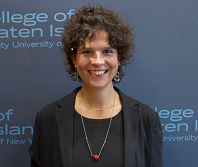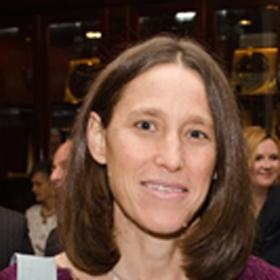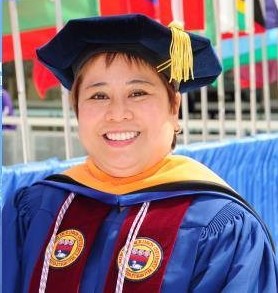Our online teaching faculty mentors are experienced online instructors who have agreed to be a part of a community of shared online resources and information. If you are looking for guidance in a particular online issue for your course design, you can reach out to some of our experienced online teaching faculty members listed below. A detailed description can be found by selecting the name of the faculty mentor.
| Faculty Mentor | Department | Technology Used in Pedagogy |
|---|---|---|
| Karen Arca-Contreras | Nursing | Blackboard (discussion boards, quizzes, blackboard collaborate, proctoring shells.), Zoom (break out sessions, polling), Survey Monkey, and You Tube, and Virtual Simulations |
| Alan I. Benimoff | Engineering & Environmental Science | Blackboard, Google Earth Pro and ArcGIS |
| Bill Bernhardt | English | Blackboard and its many interactive tools including assignments, discussion boards, groups, blogs, wikis, in-line grading and Collaborate |
| Christina Boyle | Library | Technology Used in Pedagogy: Blackboard, WordPress, Twine, Kahoot, Loom, Screencast-O-Matic, Zotero, ShareX, Prezi |
| Marta Cabral | Education | Nearpod, Perusall, Jam board, Google Suite, Slack |
| Abhijit Champanerkar | Mathematics | Blackboard, Discussion boards, Breakout rooms, Online homework systems, writing tablet |
| Orit D. Gruber | Computer Science | Blackboard, Discussion Boards, Breakout Groups, Menti.com, Word Clouds, Padlet.com, BB Virtual Office Hours, Robot Virtual Worlds, Zoom, MS Teams |
| Christina Hagedorn | English (Linguistics) | Blackboard (discussion boards, quizzes, etc.), Zoom, Slack, SimuCase |
| Susan Imberman | Computer Science | Blackboard, Discussion boards, Zoom, Screencast-O-Matic, Camtasia Studio, Microsoft Video Editor |
| Shi Jin | Chemistry | Blackboard (how to make tests less vulnerable to cheating, Blackboard Collaborate Ultra, how to make a course site more friendly to students) |
| Anat Niv-Solomon | Political Science & Global Affairs | Blackboard (discussion board, tests and assignments, blogs, journals, design), Zoom, Screen-o-matic, YouTube, Piktochart, surveys |
| Faiza Peetz | Biology | Blackboard, Discussion Boards, Quizzes |
| Jeanne-Rachel Leroux | World Languages & Literatures | Blackboard (blogs, journals, discussion boards, wikis, assignments and tests), Flipgrid video board, Loom, Google Docs, Slides and Sheets, Talkabroad conversation platform, OWL test management system, Zoom (polls and break out rooms) |
| George Vachadze | Economics | Blackboard, (discussion boards, quizzes, office hours, etc.), dropbox, youtube, calendly |
Name: Faiza Peetz, MD
Title: Adjunct Assistant Professor, Biology Department
Email
Technology used in Pedagogy: Blackboard, Discussion boards, …….
Short Statement: I have used the Blackboard Collaborate Ultra extensively for many years and now I went to a level higher since COVID. I really enjoy using the Blackboard because it is pretty straight forward. In my classes, lectures, and labs, I enjoy teaching in a synchronous mode. I do record my sessions so that the students have a chance to go back and re-listen to them if they wish to. I also use the Blackboard for my quizzes and exams, even the final. The fact that I can scramble the questions and answers, the fact that I can deny backtracking and the fact that everyone is taking the timed exam at the same time makes them pretty secure in my eyes. I use the polling questions as clicker questions. I ask questions about what I just mentioned in class and give them less than a minute to answer. It makes sure the students are actually listening to me and did not put the session on and went to take the dog on a walk, especially because nobody uses their video due to a chronic bad hair day.
Link to video
Name: Susan Imberman
Title: Associate Professor, Computer Science
Email
Website
Technology used in Pedagogy: Blackboard, Discussion boards, Zoom, Screencast-O-Matic, Camtasia Studio, Microsoft Video Editor
Short Statement: I find the most difficult part to being synchronous online is engaging students. There are times when I feel that I speak to the “void”, since all my students have their video turned off. Even when asked to type into the chat box, it is always the same small group of students that answer. Polls can help to engage, but these need to be created ahead of time. To more fully engage students, I have leveraged YouTube videos during my lectures. To enhance lectures, I use videos to illustrate a point, such as videos of historic robots. To keep things light, I may show a video to motivate the lesson for the day. For example, in my lecture on robot movement, I showed the “I Like to Move It” video from the Disney film Madagascar. Creating your own content videos, when done to professional standards, is time consuming. I believe we shouldn’t reinvent the wheel. Where there are well done videos that teach a subject topic, don’t hesitate to use them. I have used videos from excellent online instructors as asynchronous lectures. You can share your view on a topic by making use of various Blackboard tools such as the discussion board, surveys, quizzes, etc. Feel free to contact me if you have questions about ZOOM, Blackboard, or how to leverage YouTube in your lectures.
Link to video
Name: Dr. Marta Cabral (she/ her)
Title: Assistant Professor, Education
Email
Website
Technology used in Pedagogy: Examples of digital technology tools used: Nearpod, Perusall, Jam board, Google Suite, Slack
Short Statement: My name is Marta and I teach art and early childhood at the School of Education. Over the years I have used several different Learning Management Systems and have been steadily moving towards a hybrid model for the classes I teach. I am particularly interested in developing strategies to help students actively engage with content in personally meaningful ways – content that, in the case of my classes, involves artistic explorations, observations of educators and young children, fieldwork, readings, etc. I am always ready to experiment with new tools and strategies, as well as to design and redesign assignments and lessons to meet the specific possibilities and challenges that come with each new cohort of students. I am also very interested in developing strategies that promote community engagement in the classroom – the in-person classroom, but even more so in the fully online classroom. In addition, I am committed to making my courses low cost (or ideally zero cost!) for students and designing my courses using open-education resources. All of this makes me constantly think and re-think my teaching, which is demanding, labor-intensive, and… wonderfully exciting! I look forward to thinking about all this – and much more! - with you. Thank you for sharing your ideas and exploring possibilities with me.
Link to Video
Name: Christina Hagedorn, Ph.D., CCC-SLP, TSSLD
Title: Assistant Professor of English (Linguistics Program)
Email
Website
Technology used in Pedagogy: Blackboard (discussion boards, quizzes, etc.), Zoom
Short Statement: My objective in teaching remotely is to utilize pedagogical techniques and technological tools to craft an educational experience that not only meets the educational standards of face-to-face courses that I’ve previously offered, but that transcends the spatial and temporal limitations of face-to-face courses to create a particular enriching and dynamic learning experience. In my online classes, I use various aspects of Blackboard, as well as Zoom, Slack, and SimuCase. I use Blackboard to deliver course content, to facilitate discussion among students (using discussion boards), and to administer weekly low-stakes quizzes (with question order and multiple choice answers scrambled, with no backtracking permitted). I use Zoom both to record weekly content videos to be made available to students for asynchronous viewing, and also to meet with students in large and small groups. I use Slack to facilitate communication between students and myself (it seems the students’ “activation barrier” is lower for asking questions via messaging applications than using other tools). Lastly, I use SimuCase to familiarize students hoping to pursue graduate degrees in Speech and Language Pathology with various aspects of speech and language evaluation and treatment by assigning them recorded therapy sessions to observe asynchronously. Using such a tool allows students to observe sessions in clinical settings and with clinical populations of a far wider variety than would be possible if students were observing sessions in person (i.e., at a single school or hospital).
Link to Video
Name: Jeanne-Rachel Leroux
Title: Lecturer, World Languages and Literatures Department
Email 
Technology used in Pedagogy: Blackboard (blogs, journals, discussion boards, wikis, assignments and tests), Flipgrid video board, Loom, Google Docs, Slides and Sheets, Talkabroad conversation platform, OWL test management system, Zoom (polls and break out rooms)
Short Statement: In the past, I have used Blackboard, Moodle and Canvas LMS while teaching in American higher education institutions. In our current situation, I am continuously reflecting on how to teach quality foreign language instruction online and trying to build well-rounded learning experiences for our students. This August, there was the opportunity to start the semester on a better footing than when we transitionned last spring. I found designing a course orientation on blackboard very helpful for students to complete. For me, teaching online includes building social and teaching presence in the online classroom and stepping away from the lecture style during the zoom live sessions to leave room for student production. Every week, I design different break-out room activities centered around student-produced content, using google documents or the Blackboard discussion board synchronously. FRN classes are 50% asynchronous this semester and I have also been designing asynchronous video mini lectures, video board and discussion board activities, as well as Blackboard assignments, inching closer to the flipped classroom theory. I have found very interesting to organize the semester in weekly modules of learning, each with its own subset of learning outcomes. Lastly, I incorporate visuals on Blackboard specifically to describe student learning objectives and am about to start training in visuals designing tools such as Canva or Piktochart.
Link to Video
Name: Orit D. Gruber
Title: Chief CLT & Adjunct Lecturer, Computer Science
Email
Technology used in Pedagogy: Blackboard (BB), Discussion Boards, Breakout Groups, Menti.com, Word Clouds, Padlet.com, BB Virtual Office Hours, and support services after class. Virtualization software such as Robot Virtual Worlds, is used to provide virtual objects (to the students) that replicate the objects typically used on the physical campus; thereby providing the students with the necessary tools to conduct the experiments on the virtual platform. As a backup to BB, alternate virtual platforms are ready including Zoom and MS Office Teams.
Short Statement: In my class, the aim is to blend content rich material with student engagement and interaction techniques during a live, synchronous, and vibrant virtual lab session on BB Collaborate Ultra. During the first week of class, the students each submit their photo, personal message, and course expectations; this information provides the Instructor with a knowledgeable connection to the student seated in the virtual classroom. A Word Cloud, formed with all the students’ input on course expectations, is used as the course logo. During class, the Instructor and all the students have their video and (selected time) audio ‘on’. Open Pedagogy techniques are used to enhance the material and dynamic course flow. Diversity, inclusion, and equity provide the resonating tone throughout the semester. The GPS mindset model is the core essential in the class. Students contribute to the development of the course material in conjunction with the reinforcing messages of the Goals, Purpose, & Sense of Belonging (GPS Mindset model). OER resources are introduced and student contributions are encouraged across the majors. An introduction slide, displayed prior to the start of each class includes a selected student’s recommended sound track. At the end of class the students present their feedback on the current lab experiment either orally or by sharing their computer display with the class. After class students share their lab concerns, questions, and findings on an active BB Discussion Board and collaborate in an open BB virtual student lounge (Course Room); to complete their lab experiments and to prepare the final report on their results. Additional support services are available to the students including the CS Dept. Remote Tutoring Lab. Finally, each student submits the written report on BB
Link to Video
Name: Bill Bernhardt
Title: Associated Professor, English
Technology used in Pedagogy: Blackboard and its many interactive tools including assignments, discussion boards, groups, blogs, wikis, in-line grading and Collaborate
Short Statement: I teach various English Composition and Literature courses online. A lot of the students I teach are working adults with limited confidence in using technology, or with academic tools in general. For example, I find that many are indenting paragraphs and spacing lines in their essays manually instead of relying on "wordwrap" and other labor-saving features in word-processing software. In other words, one has to be careful about making assumptions about what students know, or still need to learn. This is one reason that I work with a very limited number of platforms, apps and websites in my courses. I rely primarily on Blackboard and on the asynchronous aspects of the online environment. As a result, I feel that I have been pretty successful in increasing persistence/reducing attrition in recent years. Careful course development is important, but it is never possible to make completely accurate predictions of what will happen when even the best designed courses meet actual student learners. Therefore, I tend to prioritize "course delivery" over course design and construction. In advising and mentoring colleagues, I always try to be respectful of their objectives, concerns and time, whether or not their content is familiar or their approach to teaching accords with my own. I assume that once a course has been developed and set into motion, the instructor is tasked with the responsibility to respond with flexibility to whatever happens, expected or not. My responsibility, as a mentor, is to help facilitate transactions with students that are as helpful to them as possible while, at the same time, making reasonable demands on the instructor. The price of teaching online should never be burnout! For the most part, I try to observe what is happening in the class as the basis for feedback and concrete suggestions. I don't recommend resources outside the basic CUNY package of platforms and applications, or refer busy instructors to further readings, videos, etc.
Link to Video
Name: Anat Niv-Solomon, Ph.D.
Title: Associate Professor, Department of Political Science and Global Affairs 
Email
Technology used in Pedagogy: Blackboard (discussion board, tests and assignments, blogs, journals, design), Zoom, Screen-o-matic, YouTube, Piktochart, surveys
Short Statement: Well before this year, I have found online teaching an incredibly effective way to deliver material. I believe that we provide a service to students by offering such classes. The flexibility it provides students (especially with asynchronous course design) can be highly valuable for our student body. In addition, online courses increase students’ accountability and push them to engage more with the material. In my online classes, I mostly use Blackboard. I utilize many of the functions on Blackboard including a variety of presentation features, discussion facilitation, and reflection tools that encourage students to respond to material using journals and blogs. I record mini/micro lectures and provide feedback in different ways such as written, video/audio, or using rubrics. I also use Blackboard for all of my assessment tasks and exams. To record the mini-lectures, I use Screen-o-matic which is good for both capturing my screen, as well as for editing and adding captioning. For video feedback, I mostly use my phone’s video tool and try to record outside or in different settings that will create a more personal feel. Finally, I also offer synchronized sessions through the use of Zoom meetings. This allows me to keep maximum flexibility for students, while also providing a more interactive option for individuals that find this approach more beneficial.
Name: Alan I. Benimoff, Ph.D.
Title: Professor, Engineering and Environmental Science
Email
Website
Technology used in Pedagogy: Blackboard, Google Earth Pro and ArcGIS.
Short statement: We live on the earth and it is important to understand how the earth works. In my class I love to teach different aspects of geology including natural hazards such as earthquakes, volcanic eruptions, floods, hurricanes etc. It is also important to me to tell the students about my geological research. So now we are doing distance learning. I use Blackboard Collaborate Ultra for my classes in a synchronous mode. I also use Blackboard Collaborate Ultra for exams and quizzes. This application allows us to scramble the questions and set extra time for the accommodation of students with disabilities. Now we face a different challenge namely field trips. Our geology students are required to participate in a full day field trip. As a result of Covid-19 we can no longer pack a bus with 50 students and visit field sites. So how do we do this now. Students can now participate in a virtual field trip. Videos or presentations of field trips can be downloaded via the CUNY Dropbox or You Tube. They can do this on their own time. As the students view the video, they answer questions. The students submit a field trip report via Blackboard. Alternatively, a student can take a self-guided field trip provided safety guidelines(social distancing, etc.) are followed and then submit a report via Blackboard. Students can also explore world-wide geology using Google Earth Pro.
Link to Video
Name: George Vachadze, Ph.D.
Title: Associate Professior, Economics
E-mail
Website
Technology Used in Pedagogy: Blackboard, (discussion boards, quizzes, office hours, etc.), dropbox, youtube, calendly.
Short Statement: I started using Blackboard Collaborate Ultra extensively after 2015. I do record my sessions so that the students have an opportunity to view past recordings before online homework assignments and before exams. While preparing for online assignments and online exams I create a large pool of questions and randomize answers so that it is very unlikely any two students to get different sets of questions. I make sure that questions come one at a time and deny students to go back. After the due date, I allow students to review online assignments and see the original question along with the correct answer and the answer they provided. I give an extensive discussion of why a given question is correct or incorrect. During class time, I encourage students' participation and use the polling questions as clicker questions. I use Calendly for students to sign up for office hours.
Link to Video
Name:Karen Arca-Contreras, DNP, RN-BC
Title: Assistant Professor of Nursing; Success Coaching and Student Retention Program Coordinator
Email
Website
Technology used in Pedagogy: Blackboard (discussion boards, quizzes, blackboard collaborate, proctoring shells.), Zoom (break out sessions, polling), Survey Monkey, and You Tube, and Virtual Simulations.
Short Statement: My objective in teaching remotely is to meet the course student learning outcomes for undergraduate nursing students so students can eventually meet program learning outcomes. It is important to prepare nursing students to practice in this complex health environment. Nurses are expected to make sound clinical decisions in order to optimize patient outcomes. I believe in using active learning to meet student learning outcomes. . I am well versed in the use of Blackboard, Zoom, Survey Monkey, You Tube as well as in virtual simulations.
Link to Video
Name: Shi Jin
Title: Associate Professor, Chemistry 
Email
Website
Technology used in Pedagogy: Blackboard (how to make tests less vulnerable to cheating, Blackboard Collaborate Ultra, how to make a course site more friendly to students)
Short Statement: I have been using Blackboard online tests for many years. Before the pandemic, they were mainly used to give a quiz in every class meet to keep students on track and give feedbacks to students very quickly. I also have been using Blackboard Collaborate Ultra to deliver live lectures when a class could not meet due to a (typically weather-related) condition. Now with additional months of experience, I have managed to carry out online tests on Blackboard fairly successfully (after comparing with my in-person classes in the past). In addition, I am also experienced in synchronous teaching via Blackboard Collaborate Ultra. I really liked many ways available in Blackboard Collaborate Ultra to share contents with student. The one I like the most is the combination of sharing a program with Windows ink, which enables students to see problem-solving examples in action.
Link to video
Name: Abhijit Champanerkar
Title: Professor of Mathematics
Email
Website
Technology used in Pedagogy: Blackboard, Discussion boards, Breakout rooms, Online homework systems, writing tablet
Short Statement: I have adapted well to online teaching. In my classes I love to teach synchronously using Blackboard Collaborate Ultra, and engage students in multiple ways - both during class, as well as offline. This works especially well for teaching mathematics, and enables student interaction through audio, video and chat. I make an extra effort to make sure my assignments are not all click-based by asking students to scan their work and upload on Blackboard. I like that all components of the course can be handled through Blackboard, even the online grading of scanned work. I am always open to adapting new online tools to improve my teaching methods and enhance my students' learning experience.
Link to video
Name: Christina Boyle
Title: Librarian and Assistant Professor, Library
Email
Technology used in Pedagogy: Blackboard, WordPress, Twine, Kahoot, Loom, Screencast-O-Matic, Zotero, ShareX, Prezi
Short Statement: I have been a Librarian and Assistant Professor at CSI for the past three years, and in that time I have focused on discovering and adapting various technologies to help support the educational mission of the Library. I often adapt different platforms to provide reference services to students, to support faculty with finding information about Open Educational Resources (as I am also the OER Coordinator within the Library), and to teach information literacy to students, either in my own Beyond Google: Research for College Success (LIB 102) 1-credit course, or for library instruction for other courses. LIB 102 is often offered in-person, hybrid, and online (prior to the pandemic), and students focus on learning how to perform academic and high-level research. This is a more concentrated and rigorous form of the research instruction that I provide for various courses (most notably, ENG 151 courses, where students are introduced to research). I particularly find that technologies that are more exploratory and non-linear, such as Twine, Prezi, or WordPress, can be incredibly useful for providing tutorials on how to navigate the research process. I have encouraged my own students to get comfortable and familiar with an array of technologies in order to foster skills with different types of digital tools. Technologies can be used for both synchronous and asynchronous learning, and I mostly focus on asynchronous teaching and learning.